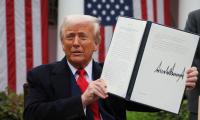Part - II
Though there was no serious confrontation between different sects in Gilgit-Baltistan during the British period, there were latent sectarian prejudices among the populace. Colonel John Biddulph in his book ‘Tribes of the Hindoo Kush’ recorded some practices and attitudes among Sunni and Shia communities that showed increasing dislike for each other among normally moderate people in matters of religion.
Biddulph served in Gilgit, Yarkand, the Pamir and Wakhan in the 19th century. Writing his observations about Sunnis and Shias, he states: “The people of Chilas…. boast that, though travellers and traders are safe in their country, no Shia ever escapes....” He also provides details about Shia behaviour towards Sunnis in these words: “In Gilgit…the greater proportion were Shias or Maulais, and it is related that any [Sunni] falling into their hands was branded with a hot iron unless he consented to become a proselyte.” Certainly, the attitudes and practices of that time have a strong affinity with the sectarian attitude in Gilgit today.
Although the independence movement of Gilgit-Baltistan is comparatively recent, it is shrouded in mystery owing to the writings of some of its prominent members who were more concerned with cultivating personality cults by reducing objective history into an epic of their heroism to turn the whole historical process in their favour. With the rise of sectarianism and increasing radicalisation, history once again has become victim. So far, no research has been carried out regarding the attitude of different sects during the independence movement. However, there are some oral and written proofs which point at sectarian undercurrents within the composition of leaders and forces of movement of autonomy.
Soon after independence, the revolutionary forces established independent political setup in Gilgit-Baltistan. The former raja of Gilgit, Shah Rais Khan, was appointed as the president of Gilgit-Baltistan and the head of the Gilgit Scouts, Colonial Hassan Khan, as the chief of armed forces. Because of their numerical strength in forces and majority in the region, the ruling elites of this newly born state were mainly comprised of Shias. Since the majority of soldiers and leaders in the war of independence hailed from the Ithna Ashari and Ismaili community, some Sunnis felt that they would be made subservient to the majority’s will. When a section of Sunnis in Gilgit-Baltistan perceived that the elite political and administrative positions were held by Shias, they started to feel insecure. That is why they started to develop a plan for their safety. In the early days of independence, a Sunni delegation under the leadership of a cleric from the Damote village in Gilgit reportedly went to Karachi to meet the Pakistani leadership and discuss the annexation of Gilgit-Baltistan with Pakistan.
Some sections in Gilgit-Baltistan claim that the demand to merge it with Kashmir aims at turning the Sunni minority status into a majority. The roots of these demands can be traced back to the Kashmir conflict in 1948. The Pakistani state appended Gilgit-Baltistan with the Kashmir imbroglio. That is why its constitutional status has remained in limbo for last 69 years. Some analysts see the efforts to link the region with the Kashmir issue by Kashmiri political parties as a covert attempt to turn the Shias into a minority. On the other hand, the Shia community considers itself as the biggest stakeholder in the region, and tries to derive its legitimacy for rule from the fact that there were more Shia and Ismaili martyrs than Sunnis in the Gilgit-Baltistan Freedom Movement.
The post-independence period in Gilgit-Baltistan is marked by new administrative arrangements by the government of Pakistan. Gilgit-Baltistan remained an independent state for 16 days with Raja Shah Rais as its first and last president. He was replaced by a political agent, Alam Khan. Since then, the region has remained under the strong control of the bureaucracy. This is a period when several political movements started against the local rajas of Punial, Nagar and Hunza. In Punial, people agitated against the local raja in 1952, resulting in the killing of five people. Similarly, people stood up against the atrocities of the rajas of Hunza and Nagar in the late 1960s and early 1970s.
Some people mark 1971 as the starting point of sectarian violence, which was instigated by the state when the commandant of the Gilgit Scouts intimidated the headmistress of Fatah Bagh Girls Schools. That triggered a violent protest in Gilgit town. When the late Johar Ali and his comrades increase political pressure on him, the resident commissioner sought the help of a particular sect and turned an administrative issue into sectarian one. Some oral sources claim that when Johar Ali held protests and rallies against the intimidation of the local headmistress, the Sunni community did not take a serious interest in these. In the following year, Syed Asad Zaidi made an inflammatory speech against the Sunni community. Later he became the deputy speaker of the Northern Areas Legislative Council (NALC). Asad Zaidi was assassinated on April 20, 2009 in Kashrote.
The first incident of sectarian violence in Gilgit-Baltistan took place not during the rule of General Ziaul Haq, but in the reign of Zulfiqar Ali Bhutto. Some segments in Gilgit-Baltistan accuse Bhutto for initiating the policy of divide and rule. He is accused of abolishing the Gilgit Scouts for fear that they would not follow the orders of the government of Pakistan and prefer to protect their own people. It is during the decade of the 1970 that the issue of the route of the Moharram procession became a bone of contention. Before that it was normal for Sunnis to facilitate the procession by providing water and cloth pieces to the mourners.
In 1972, Sunni leaders demanded that the assembly at the end of the procession be shifted to another place. But the Shia community disagreed with that. Three years later, in 1975, the Shia assembly was shot at from a Sunni mosque. The ensuing events led to the mobilisation of thousands of people from the Chilas, Darel and Tangir valleys to support Sunnis in Gilgit, whereas Shias were mobilised from the Nagar Valley. However, the security forces managed to keep armed supporters at bay from Gilgit city. This is a major event also for its long-term impact as it polarised the hitherto closely knit kinship-based communities in Gilgit on a sectarian basis. Thereafter, people have increasingly started to identify themselves on the basis of sect. The shift in markers of identity paved the way for religious extremism and sectarian violence in the following decades.
Gen Ziaul Haq’s rule is crucial to the history of Gilgit-Baltistan. Immediately after imposing martial law, he declared the region of Gilgit-Baltistan Zone C. By doing so, he extended the subjugating rules to Gilgit-Baltistan. It is ironic that every government extends only subjugating rules, instead of empowering ones. When it comes to empowerment, Zia supported a particular version of Islam and groups that could help him perpetuate his rule. Zia’s time is very important because of the regional and local geopolitical and social dynamics of Gilgit-Baltistan. Bhutto abolished the local Rajgi/Miri system in 1974. Though it was a commendable step, he did not introduce alternative institutions.
Traditionally, the ulema did not have an important role in the decision-making process of the local princely state. Their role was limited to the private sphere. However, Zia’s support to particular religious parties and groups and the existing power vacuum in Gilgit-Baltistan provided an opportunity for the ulema to assert their role in public space. It is a period that witnessed the mushrooming of seminaries and introduction of curriculum that propagated a particular version of faith. The Islamisation process of Zia was welcomed by Sunni leaders thinking that it could protect their interests from the majoritarian politics of the Shia community.
To be continued
The writer is a freelance columnist based in Gilgit.
Email: azizalidad@gmail.com
Those who wield technology not only change their destiny but alter very definitions of power
Now, extending state-driven trade strategy, US has imposed reciprocal tariffs on goods from several countries,...
Pakistan must first therefore undertake complete overhaul of its educational landscape
Once products are manufactured and ready for distribution, transportation further contributes to environmental harm
Effective foreign exchange regulation can also help prevent currency manipulation and illicit financial activities
Dr Ishrat had joined Pakistan’s civil service during its most glorious times







